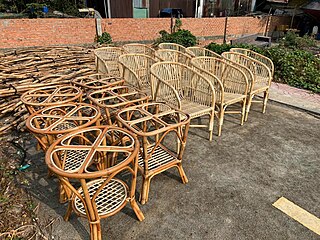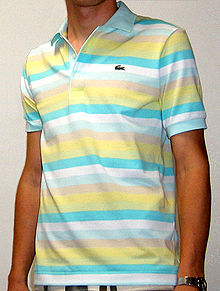
A handicraft, sometimes more precisely expressed as artisanal handicraft or handmade, is any of a wide variety of types of work where useful and decorative objects are made completely by one's hand or by using only simple, non-automated related tools like scissors, carving implements, or hooks. It is a traditional main sector of craft making and applies to a wide range of creative and design activities that are related to making things with one's hands and skill, including work with textiles, moldable and rigid materials, paper, plant fibers, clay, etc. One of the oldest handicraft is Dhokra; this is a sort of metal casting that has been used in India for over 4,000 years and is still used. In Iranian Baluchistan, women still make red ware hand-made pottery with dotted ornaments, much similar to the 5,000-year-old pottery tradition of Kalpurgan, an archaeological site near the village. Usually, the term is applied to traditional techniques of creating items that are both practical and aesthetic. Handicraft industries are those that produce things with hands to meet the needs of the people in their locality without using machines.

Huế is the capital of Thừa Thiên Huế province in the North Central Coast region of Vietnam, located near the center of Vietnam. Huế was the capital of Đàng Trong from 1738 to 1775 and of Vietnam during the Nguyễn dynasty from 1802 to 1945. The city served as the old Imperial City and administrative capital for the Nguyễn dynasty and later functioned as the administrative capital of the protectorate of Annam during the French Indochina period. It contains a UNESCO-designated site, the Complex of Huế Monuments, which is a popular tourist attraction. Alongside its moat and thick stone walls the complex encompasses the Imperial City of Huế, with palaces and shrines; the Forbidden Purple City, once the emperor's home; and a replica of the Royal Theater.

A shirt is a cloth garment for the upper body.

Brown rice is a whole grain rice with the inedible outer hull removed. This kind of rice sheds its outer hull or husk but the bran and germ layer remain on, constituting the brown or tan colour of rice. White rice is the same grain without the hull, the bran layer, and the cereal germ. Red rice, gold rice, and black rice are all whole rices with differently pigmented outer layers.

Áo dài is a modernized Vietnamese national garment consisting of a long split tunic worn over silk trousers. It can serve as formalwear for both men and women. Áo translates as shirt and dài means "long". The term can also be used to describe any clothing attire that consists of a long tunic, such as nhật bình.
An upturned collar is an otherwise flat, protruding collar of either a shirt, Polo, jacket, or coat that has been turned upward.

A dress shirt, button shirt, button-front, button-front shirt, or button-up shirt is a garment with a collar and a full-length opening at the front, which is fastened using buttons or shirt studs. A button-down or button-down shirt is a dress shirt with a button-down collar – a collar having the ends fastened to the shirt with buttons.
The Izod Corporation is an American midrange clothing company that produces dressy-casual clothing, sportswear for men, and footwear and accessories. It is a division of Authentic Brands Group, and is currently marketed and manufactured by Centric Brands under a long-term licensing agreement. Other Izod classics include the Harrington jacket G-9 model and V-neck and cardigan sweaters. Today, the closest competitor of the Izod brand is the Chaps brand owned by Ralph Lauren Corporation, while the U.S. Polo Assn. brand is also an indirect competitor.

Vietnamese clothing is the traditional style of clothing worn in Vietnam by the Vietnamese people. The traditional style has both indigenous and foreign elements due to the diverse cultural exchanges during the history of Vietnam. This all eventually led to the birth of a distinctive Vietnamese style of clothing, including the birth of the unofficial national dress of Vietnam, the áo dài.

Áo bà ba is a traditional southern Vietnamese garment. The top part which covers the torso is called the áo. It is mostly associated with rural southern Vietnam, especially in the Mekong Delta. Often worn as a top and bottom set, the áo bà ba is typically a long-sleeved, button-down silk shirt with a scooped neck, paired with silk pants. The shirt is long and split at the waist sides, forming two flaps customarily with two pockets.

The áo giao lĩnh, referred to as the giao lãnh y in Literary Chinese texts. Folk often call it áo tràng vạt or áo tràng xiên, referred to as áo tràng, was a traditional cross-collared robe worn by Vietnamese before the 19th century. It was influenced from Han Chinese clothing and was typically worn by the royalty, the aristocracy, the nobility, and the commoners. During the Nguyễn dynasty, the áo ngũ thân was commonly worn and the áo giao lĩnh was only worn in formal occasions.

The Z111 Factory, formally registered as the 11 Precise Mechanical One Member Liability Company, is a state-owned firearms factory located in Thanh Hoá, Vietnam.
Meritorious Artist Thành Được was a Vietnamese actor and singer.

Trần Thị Nguyệt Thu is the former Spouse of President of Vietnam during her husband Nguyễn Xuân Phúc's presidency from April 2021 to January 2023, when he resigned amid a series of corruption scandals. She was previously the Spouse of the Prime Minister during her husband's premiership from 2016 to 2021. She is known for her elegant fashion style, often wearing the traditional Vietnamese dress áo dài, and is occasionally dubbed the First Lady of Vietnam by the overseas Vietnamese press.

Trần Thị Duyên is a Vietnamese women's footballer who plays as a defender for Phong Phú Hà Nam football club and the Vietnam women's national football team.

The Vietnamese Rattan and Bamboo Industry is a traditional handicraft industry that has been practiced for centuries. It is based on the use of two basic materials rattan and bamboo. Craftsmen in this industry specialize in creating a variety of handicrafts, from everyday household items to complex works of art. Products from Vietnamese rattan and bamboo villages are present in 130 countries, generating an average revenue of over $200 million per year, accounting for 14% of the value of handicraft exports. Vietnam currently has 893 villages specializing in rattan and bamboo weaving, contributing 24% of the total number of villages, including 647 rattan and bamboo villages and 246 wicker and lotus villages. Approximately 342,000 farmers are involved in the production of these products.














